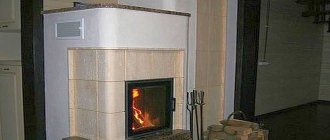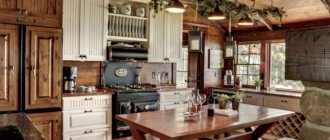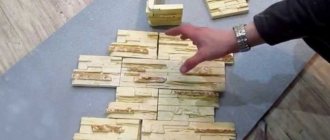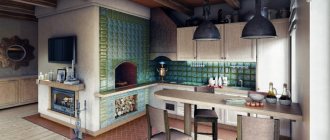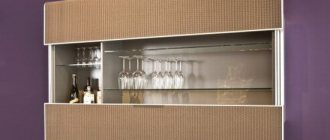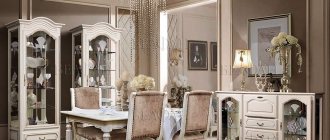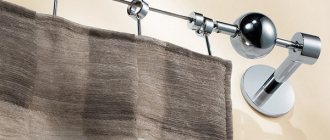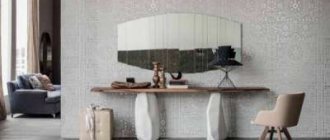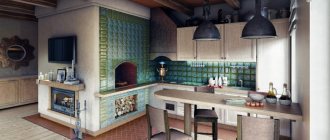The stove in the house acts not only as a source of heat, but is also an original element of the interior. A carefully executed stove lining will create a bright accent of style in the decoration of the entire room. Let's consider various options for lining furnaces, the materials used, their advantages and disadvantages, and also reveal the secrets of cladding technology. After reading to the end, you will definitely form an opinion on which cladding is suitable for your stove.
Furnace lining Source pinimg.com
Types of facing tiles
Finishing the stove with plaster is gradually becoming a thing of the past, and lining various types of stoves with tiles is becoming increasingly popular. Manufacturers offer various types of facing tiles. They differ in composition, production technology and design ideas.
- Clay based tiles . The most common type. It includes classic tiles, durable fireclay, exquisite terracotta and other types of tiles.
- Tiles based on natural stone . Marble tiles take pride of place in this category. Even the most severe critic will appreciate the marble-lined stove.
- Tiles based on artificial stone . The main component of the sample is cement. On its basis, with the help of various additives, a durable facing material is formed.
Variety of cladding Source kamin-spb.ru
When determining the type of tile for finishing a stove, it is necessary to consider the requirements for it. Let's take a closer look.
Gearbox Dimensions
The thickness of the furnace gearbox is most often 8 mm. Clinker and porcelain tiles for fireplaces can be thinner - 5–6 mm. This material is quite durable, and heat capacity is not so important when finishing a fireplace.
- Tile sizes vary within very small limits. Experts say that CP larger than 25*25 cm should not be used. The number of seams in this case does not matter, and working with large tiles is very inconvenient: there is a lot of trimming, and the heat-resistant glue may not withstand the weight of the material.
- Small tiles - less than 10*10 cm are not used for the same reason: they are too inconvenient to work with. In addition, such finishing crushes the stove surface, and it is not so large.
- Much larger porcelain stoneware slabs are used for facing fireplaces. But, since this material is quite difficult to adjust to size, the cladding elements are made to order.
Now let's find out how the lining of bathhouses, brick, Russian, heating stoves and fireplaces with ceramic tiles (tiles) is carried out.
Requirements for facing materials
The facing tiles for the stove will be used in difficult temperature conditions, so the following requirements must be met:
- Naturalness . The tiles should not contain toxic substances; as a rule, when heated, they are released into the environment, which is unacceptable from an environmental point of view.
- Fire resistance . The material must work at temperatures up to 10000C.
- Good thermal conductivity . The material should not interfere with the heating of the room, but prolong it.
- Moisture resistance . With low water resistance of the tiles, the oven may become damp.
- Durability . The thickness of the sample is assumed to be at least 6-8 cm.
- Attractiveness . The appearance of the lined stove should match the interior, be attractive and elegant.
Attractiveness of cladding Source tulikivi72.ru
Properties and characteristics
Any types (types) of fire-resistant tile products, regardless of materials, methods of their manufacture, must have the properties required by construction, fire safety, and sanitary standards:
- Fire resistance – the ability to withstand short-term temperature exposure up to 1000 ℃.
- The maximum heating temperature on the outer surface during operation under normal conditions, which, depending on the category and purpose of the furnace equipment, varies in the range from 100 ℃ (moderate heating) to 120 ℃ (high temperature heating). The temperature limits for each type of refractory tile are determined during testing and are indicated in the accompanying technical documentation for each batch of products.
Determination of fire resistance limit
- The absence of toxic substances in the composition, including those formed during high-temperature heating, which is solved by the use of fire-resistant natural raw materials or natural materials without harmful impurities.
- Thermal conductivity, heat capacity, important properties that make it possible not to reduce the heat transfer of furnace equipment made of refractory bricks.
- Low porosity, high density, low water absorption - all these properties are inextricably linked.
- Fracture strength, point impact load.
- Resistance of paint layers and enamel coatings to external influences.
- Resistant to fading of original colors and designs.
Specifications:
Types of facing tiles
Today, on the construction market, tiles for stoves and fireplaces are presented in a wide range. Choosing the best one is not at all easy, but by studying the main options used in cladding, you can understand what is right for you.
Fireclay tiles
The most worthy option for cladding. It is made on the basis of refractory clay interspersed with stone flour, which significantly increases the strength of the sample.
Significant advantages include:
- Maximum fire resistance and heat resistance.
- Resistance to low and high temperatures.
- Neutrality to any aggressive environment.
- High strength.
- Excellent load resistance (due to composition and significant thickness).
- Does not rub, does not slip, does not crack.
- Durability. From experience, fireclay tiles are laid once and for all.
The severity of fireclay tiles Source strojdvor.ru
Cladding with fireclay sample in a combined version Source feeder.kiev.ua
Disadvantages: high cost of the material and little variety in the design of the tiles.
Terracotta
Terracotta is a relatively inexpensive cladding option with a wide range of artistic designs. Terracotta tiles are known for their rough surface and are an imitation of natural stones or brickwork.
Made from kaolin dense, pre-compressed clays. The firing temperature is above 10000C. Terracotta tiles for the stove have a natural surface, but can also be presented with a glazed decorative glossy layer.
Significant advantages include:
- Durability, mechanical strength.
- Stability at different temperatures.
- Fire resistance, high thermal conductivity and excellent heat transfer performance.
Nice terracotta Source postila.ru
Disadvantages: low strength under mechanical stress, and if the cladding is often subjected to mechanical and dynamic loads, it will begin to crumble.
Majolica
It is considered an improved version of glazed terracotta. Made from refractory clay characterized by high porosity. Majolica has its own characteristics, thanks to which it is easy to recognize:
- The shapes are smooth, the edges are rounded.
- It is decorated with white glazed paint, onto which a design is applied manually. Shiny surface.
- Floral motifs in the ornament.
- The predominance of green-blue and brown-yellow shades.
Exquisite majolica Source kamin-keramik.ru
The cladding has all the characteristics of heat resistance. The disadvantage is that it is expensive, but decorating the stove with majolica is worth the money.
Metlach
An interesting option for oven cladding. Metlakh fire-resistant tiles are folded into intricate mosaics, creating unique patterns in the interior. The sizes are small. Brooms are not difficult to stack. It is not demanding in operation.
Distinctive features of the broom:
- not covered with glaze;
- heterogeneous in color scheme;
- manufactured under high-temperature firing conditions (maximum heat resistance);
- durable (comparable to porcelain stoneware).
Amazing broom Source iz-kirpicha.su
Recommends itself well in places with high humidity and works in conditions of maximum temperatures.
Tiles
Tiled tiles for cladding stoves and fireplaces will be the ideal solution. A distinctive feature of the tiles is its unusual geometric shape. Along the perimeter, the tile has “sides”, thanks to which its shape resembles an open box.
Fact! By using tiles in the cladding, the efficiency of the stove can be increased by 10-15%; the heat-saving qualities of this material are very high!
Tiles are durable and environmentally friendly. The choice of colors is very wide. The design is applied by hand, so the products are very expensive. There are dimensional errors, so installation may be difficult.
Stove decorated with tiles Source stroyland.biz
Clinker tiles
An ideal option for cladding fireplaces in a matte version, although products can also have a glazed front side. It is made by mixing several types of clay with the addition of special mineral dyes to give color.
Clear advantages include:
- durability (does not crack);
- color fastness (does not fade, does not fade, does not fade);
- good density indicator (in comparison with terracotta and its varieties);
- resistance to temperature differences.
Unusual clinker Source rusolymp.ru
Clinker tiles for a fireplace are good, but have the disadvantage of lack of calibration during manufacturing, so an error in the size of the samples can create difficulties in installation.
Marble tiles
Marble is good for its majestic ornamentation and chic finish. Stoves are rarely lined with this material, but marble tiles on fireplaces are not the last place in the choice of cladding.
The advantages of marble are determined by durability, color and texture fastness, environmental friendliness and aesthetics. Disadvantages: high cost of products.
Furnace in marble Source mramoroff.com
See also: Catalog of companies that specialize in the design and installation of fireplaces and stoves.
Luxurious marble fireplace decoration Source 2gis.com
Faience
Earthenware is made by dry pressing several types of refractory clays with an admixture of quartz sand. Much stronger than, for example, majolica, so you can use thinner tiles, only 4-5 mm thick, for cladding.
The material is inexpensive. Aesthetically, it is classic faience: white tiles with blue ornaments, no worse than expensive tiles or broomsticks.
Lightness of earthenware Source msk-kamin.ru
Tile
The product has good heat resistance, but the tile is very sensitive to temperature changes.
Fact! If the room is constantly kept warm, finishing the stove with tiles will be an excellent cladding option.
When freezing (no firebox in winter), the tiles will peel off and the glazed surface will crack. The strength is low, the service life is short.
The advantages include ease of care, variety in color and inexpensive cost of products.
Classic tiles in the stove lining Source kitchenremont.ru
Porcelain tiles
It is characterized by a practically zero coefficient of water absorption, due to the monolithic structure. It is produced by mixing several types of clay with quartz sand and marble chips. The coloring is created by adding salts of various metals.
This is interesting! Porcelain tiles are often represented by imitation of marble, granite tiles and even majolica, that is, for a relatively low cost you can line the stove with imitation in expensive shapes and colors.
The advantages include high heat resistance, resistance and durability. Strength is ensured by a tile thickness of 9-12 mm.
Brutal porcelain tile Source yandex.net
Fake diamond
The product made from cement mortars is presented as an imitation of various types of stones, bricks, and other types of finishing. Tinted with various pigments.
The stone is durable and not difficult to use. In terms of technical characteristics, it fully corresponds to natural stone.
An interesting solution - artificial stone Source yandex.net
What is and purpose
Refractory tiles are, according to the definitions given in GOST 28874-2004 and GOST R 52918-2008, a type of molded refractory materials (products), since they are characterized by certain geometric shapes and standard sizes available for all serial products.
The main purpose of tiles made from both natural finishing stones and artificial ceramic materials, regardless of its type, be it ceiling, facade or floor, is decorative, protective cladding of the surfaces of building structures, heating household, industrial equipment, including stoves , fireplace, without which a modern bathhouse, sauna, residential or country house is impossible.
Fireproof materials and their fire resistance
Ceramic heat-resistant tiles are multifunctional products that allow solving several problems facing customers - from builders constructing objects for various purposes to private property owners:
- Create a unique interior in a residential, country house, bathhouse, sauna, using fire-resistant tiles that are suitable/liked in appearance, texture, color, pattern for decorative cladding of the external surfaces of stoves, fireplaces, including fire-resistant cuts and offsets; as well as stationary grills and barbecues located in personal plots.
- To provide protection against overheating of heating equipment, to reduce the possibility of thermal damage to people using it at home and at work.
- Increase the heat capacity of stoves and fireplaces, increase the uniform heat transfer of heating units by creating even, smooth outer surfaces that effectively act as heat shields.
Tips for choosing cladding
Today, finishing a stove with tiles in a private home is not a luxury. A stove, as an element of the interior, having a special function of heat, can become a real decoration of the room. The choice of cladding is huge; when choosing, you should focus on the following:
- Budget . You can line a stove, for example, with terracotta tiles relatively inexpensively, but when choosing majolica or marble, you need to understand that the price will be many times higher.
- Style . The stove cladding is carried out in the same style as the interior of the room.
- Space . If the area of the room and the ceiling height are small, a large product will look ridiculous, it is worth choosing small-sized ceramic mosaics. On the contrary, a large stove or tall fireplace should be lined with natural stones, marble or porcelain stoneware.
- Quantity : it is worth purchasing with a 10% reserve.
- Tinting . In a calm interior, plain tiles would be appropriate; in a bright and modern interior, chic majolica or tiles would be perfect.
Choosing a strict aesthetic Source cloudfront.net
Tiles and majolica Source puzzleit.ru
The choice of cladding is associated with its technical characteristics specified in the product labeling from the manufacturer.
Marking
Marking allows you to evaluate the quality of the cladding:
- Water absorption coefficient. For finishing the stove, no more than 3% is allowed. Designated "E". Granite tiles have the best water resistance of 0.5%.
- Porosity. It is designated “PEI”, followed by numbers from I to V. For stoves, you should choose material marked PEIIV-PEIV.
- Dimensional accuracy. Marked "A" and "B". This stands for computer-aided design of the pattern. The highest accuracy is marked “A”. This product is much easier to install.
- Chemical resistance. Designated “EN122” with letters from A to D. For stoves it is better to choose “A”.
Labeling symbols Source kuhnyamy.ru
- Variety 1st grade is declared by the manufacturer to be of high quality, defects in the batch are up to 5%, 2nd grade allows 5-25% of defects, 3rd grade – more than 25% of defects.
- Environmental standards. The designation “ECO” or “Eurostandard” on the packaging will guarantee the environmental safety of the product.
- Linear dimensions. The optimal dimensions are no higher than 250x250 mm on the sides. The optimal thickness is 6-8 mm.
Design
Classic stove tiling is characterized by the absence of geometric shapes and a deep richness of complex ornaments, made mainly on the basis of plant patterns. Design solutions determine their place in the interiors of premises:
- In a village house, the cladding is supposed to be natural stone.
- The classic interior will be emphasized by porcelain tiles.
- In modern-style rooms, cozy terracotta in a matte finish would be appropriate.
- Interiors in a modern style will flourish with a stove lined with majolica or tile patterns.
Furnace design Source yandex.net
Colors
The color range of cladding is very diverse. It is selected to match the given tone of the entire interior of the room.
- Marble is presented in the most unusual colors: from soft white to strict black.
- Granite in natural colors is less varied. The tiles are gray, brown or black.
- Ceramics are not limited in the choice of colors. The samples delight with a variety of shades and colors: from the most delicate light colors to the most saturated colored and dark tones.
Multicolor in decoration Source repairblog.ru
Fireplace styling options
In modern homes, it is not only a source of heating, but also an interior decoration, so it is simply necessary that it be decorated aesthetically and tastefully. Let's see in what ways it can be done.
Under Gzhel
Original Russian traditions are still relevant today. It is enough to take white tiles with patterns made in blue tones, and you will see how the room will be transformed: it will become visually larger and more positive. At the same time, you will increase the efficiency of the heating device and improve the level of safety.
Under the stone
The result is a relief surface that quite accurately imitates masonry made from natural cobblestones. It looks impressive and has a homely, spiritual feel - you want to gather around such a fireplace with the whole family. And to create beauty, you just need to pour a mixture of cement, sand, gypsum, perlite and other fillers into a pre-prepared mold that replicates the texture that interests you. The result will be durable enough for many years of use.
Under the brick
The choice for those cases when you need to emphasize the simplicity or even brutality of the room. Thanks to this design solution, the heating device looks as organic as possible in the interior, because with its entire appearance it continues the design of the walls. Ideal for a loft-style room.
Mirror tiles
It looks chic and ultra-modern, fits perfectly into the framework of high-tech, modern, and minimalism. Places the right accents, reflecting the light of a chandelier and sconce, candle flames, visually expands the space, and creates interesting graphic effects. You just need to plant it on a special reinforced glue that can withstand up to 400 °C.
Panel
Images are created on top or on the sides of the firebox: stones, wood, plants, eclectic patterns, recognizable ornaments, if desired, even textile motifs that repeat the texture of the canvas.
Cladding technology
Furnace cladding can be done in two ways: with glue or with metal profiles without glue. Before cladding, it is necessary to carry out comprehensive preparation.
How to prepare for cladding
Before tiling the stove, you must:
- Clean the stove from plaster. To facilitate the process, you can use a spray bottle. Once the surface is wet, removing the plaster with a spatula is not difficult.
- Remove remaining particles with a brush. To do this, re-wet the surface of the oven, then clean it. The seams are deepened. Cleaning is done with hand tools, or you can use a grinding machine.
Cleaning with a grinder Source rems-info.ru
Cleaning by hand and with a drill with attachments Source gidpokraske.ru
Important! If you plan to line a new stove, then after finishing the masonry you need to wait six months for the stove to settle!
- Prime the surface of the oven. This will ensure adhesion and additional protection. It is advisable to prime two layers. Before applying the second coat, you need to make sure that the first coat of primer is dry.
Wall priming Source vse-otoplenie.ru
- Level the surface using a 10 mm thick clay mortar. Differences in the wall are unacceptable. The clay mixture is applied to the surface with a spatula and leveled using the rule. The corners are secured with metal corners.
- Lay the reinforcing mesh, pressing it into the solution before it dries, then leave the walls to dry.
- After drying, apply final priming and leave the oven until completely dry.
With smooth walls, the mesh can be stretched without leveling. Source stroyfora.ru
Preparatory work
First of all, the stove or fireplace, as well as adjacent surfaces, must be prepared. To do this you need:
- Remove the previous facing material, if any.
- The cleaned surface must be cleared of dust and dirt, and the seams in the brickwork must be deepened.
- To ensure that the fireplace tiles hold securely, the surface is carefully primed. You need two or three layers, with breaks for drying. It is best to apply the composition with a roller, and treat hard-to-reach areas with a paint brush.
- The mesh for reinforcement is stretched. Some do not reinforce the surface, however, it all depends on the situation.
- If there are destroyed or damaged corners of the structure, they need to be strengthened. For this purpose, you can use special overhead metal corners.
Why do reinforcement before covering a ceramic stove with tiles? It is needed to strengthen the surface of the wall. If the stove is old and is already beginning to collapse, then reinforcement cannot be neglected. The facing material will additionally load it.
Video description
Watch the video on how to attach the reinforcing mesh to the wall of the stove, if the solution is not applied.
After carrying out a set of preparatory work, you can proceed directly to the installation of the facing tiles.
Cladding with glue
Before starting installation, you must prepare the correct adhesive solution. The main components are PVA glue and cement compounds. You can add salt. The main thing is to maintain the proportions correctly.
For a person who does not have experience in preparing the solution, preparing the glue can be quite a difficult task. There is another option - buying a ready-made adhesive solution at a hardware store.
Ready-made glue Source stroyfora.ru
Classic finishing of the stove in the house with facing tiles begins with cutting the tiles. This is a complex process, but with all the necessary tools, the cutting process can only take a couple of hours.
When the glue is prepared and the tiles are cut, proceed directly to installation:
- Work begins with laying the first row. This is done using a building level and a horizontal marking cord.
- The adhesive is applied to the tiles and leveled using a notched trowel.
- A tile with an adhesive composition is applied to the furnace wall and pressed with force. The first tile must be aligned not only vertically, but also horizontally. Subsequent ones are aligned relative to the first.
Attention! The glue begins to set within 7-10 minutes. The position of the tiles must be adjusted immediately during installation.
Applying cladding to glue Source standart40.ru
The process of creating seams
When the cladding work is completed, you need to wait a day and then start grouting the joints. It is better to do it with a special gun.
There are three ways to process seams:
- Using asbestos cord. It is needed for caulking the seams, after which it is filled with a composition for wall cladding.
- Using heat-resistant silicone-based sealant. This is the grout that is applied with a gun.
- Using heat-resistant glue. It is suitable when seams are no more than 3 mm.
In addition to the gun, grout can be applied with a rubber spatula. And in order not to stain the surface of the ceramic tiles, use masking tape.
Video description
This video shows the combined lining of the stove with artificial stone
Cladding without glue
The installation method without glue is more labor-intensive, but has advantages over the adhesive method. If it is necessary to replace one or more tiles, there is no need to disassemble the entire surface; it is enough to dismantle the damaged ones and put new ones in their place. The cladding in this case is a “constructor”.
An example of dry cladding Source ytimg.com
With this method, tiles for cladding stoves are installed using a dry method. The design is more durable and heat-intensive. It does not require a large complex of preparatory work: the stages of removing old plaster and cleaning can be eliminated in this case.
- Using a building level and a cord, the future frame is marked. The surface of the oven is lined relative to the width of the tiles with a margin of 2 mm for seams.
- A metal frame is mounted. Aluminum profiles and corners are attached to the anchors. The result is a frame structure.
- The frame is checked by running the tiles along the guides. The element must move freely without difficulty or jumping out of the frame.
- The frame is filled with tiles.
- The structure of vertical corner profiles and corners is secured to the self-tapping screws.
This is what a stove lined with the dry method looks like Source ytimg.com
In conclusion, we note that lining a stove with ceramic tiles will visually ennoble any stove. The lined stove will become a bright element of the interior, continuing to fulfill its main purpose of heating the room.
Functions
The furnace lining performs a number of specific functions:
- reducing the time required to heat the room;
- ensuring ease of maintenance of the device - cleaning tiles is much easier than, for example, a plastered surface;
- attractive decor;
- increase in heat transfer and heat capacity of the furnace;
- psychological aspect - according to most psychologists, the presence of a traditional stove in the house has a good effect on the general atmosphere in the home, as well as the mood of others.
Briefly about the main thing
There are several types of facing tiles: based on clay, natural or artificial stone. The material must be fireproof, heat-resistant, durable, not absorb moisture, conduct heat well and at the same time have an attractive appearance.
The building materials market offers models for every taste and budget: pretty terracotta and harsh fireclay tiles, amazing majolica and delicate faience, majestic marble and modest tiles, strict porcelain tiles and luxurious brooms.
There are two cladding technologies: glue and metal frame. The choice of tiles is made according to technical characteristics, taking into account markings, design and colors, and cladding technology according to the expected operating conditions.
Where is it used?
Fireproof tiles for fireplaces and stoves are used primarily as a decorative element for the surfaces of heating devices. Thanks to tiles, these objects can be transformed into a real work of art, giving a stove or fireplace a personal touch, or finishing in accordance with certain cultural traditions.
An excellent example is the Russian stove, which is still used in homes directly for its intended purpose or as a bright element of room decor.
Tiles are not used for finishing the space around the stove, working and internal surfaces.
All types of fire-resistant tiles must have a quality certificate. Only with supporting documentation can we say that the material will meet the declared characteristics.

